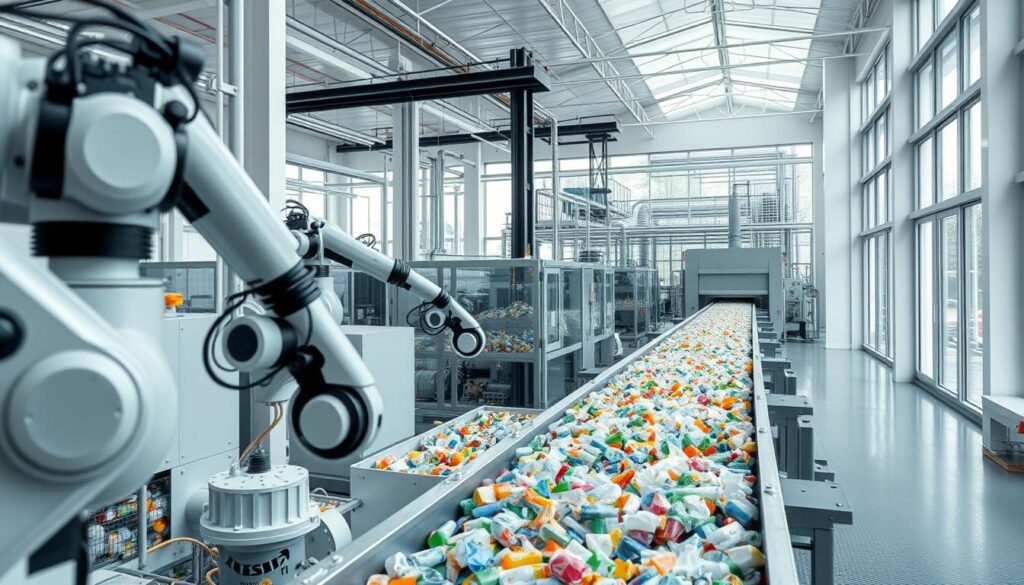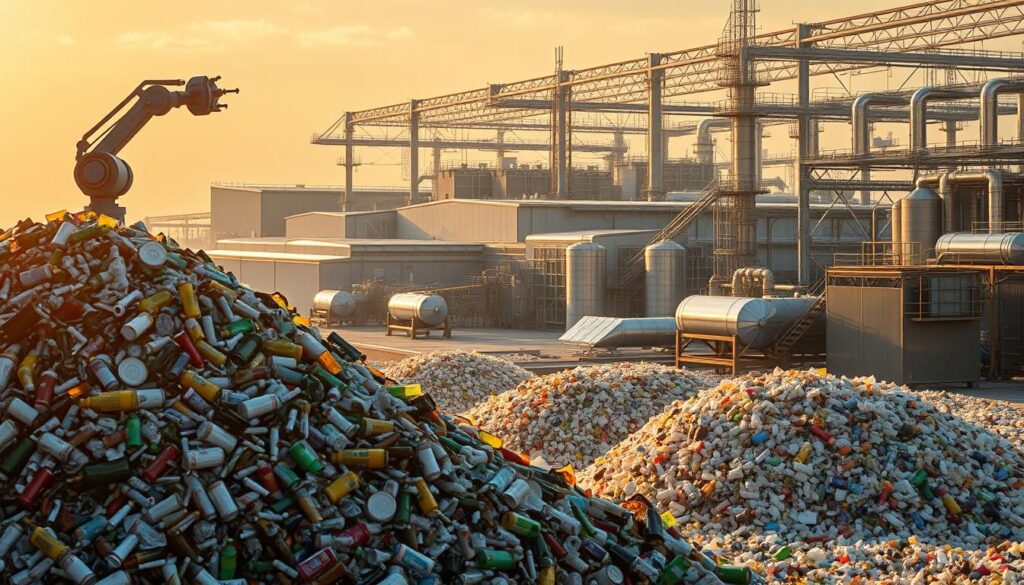Did you know the U.S. generates over 35 million tons of plastic packaging waste yearly? Most ends up in landfills or oceans. But in Pennsylvania, Shell is rewriting this story with a groundbreaking solution that transforms recycled plastic into valuable resources, diverting it from our environment and giving it new purpose.
Their cutting-edge facility transforms discarded materials into premium polyethylene (PE) using advanced chemical recycling. This tech breaks down different types of post-consumer waste into raw materials. The result? High-quality PE that meets strict industry standards—without relying on new fossil fuels.
Here’s how it works: Waste is collected, sorted, and processed through molecular-level conversion. Impurities are removed, creating a clean base for durable products. This approach tackles two challenges at once—reducing landfill dependency and offering manufacturers sustainable alternatives.
Shell’s innovation proves circular solutions aren’t just possible—they’re profitable. By turning trash into treasure, they’re setting new benchmarks for the plastics industry. Want to see how this game-changing process could reshape packaging and production? Let’s dive deeper.
Innovative Journey: Shell’s Sustainable Transformation in Plastics Manufacturing
Imagine turning yesterday’s trash into tomorrow’s essential materials. That’s the vision driving Shell’s Pennsylvania facility, where everyday items like packaging and containers get a second life. Their approach tackles a pressing issue: transforming discarded resources into high-value products while slashing environmental harm.
From Waste to Resource: The Big Picture
Traditional methods often struggle with mixed or contaminated materials. Shell’s system changes the game. Advanced sorting separates usable polymers from non-recyclables, while shredding prepares them for chemical breakdown. Guides from leading recycling institutions highlight this step as critical—cleaner inputs mean higher-quality outputs.

Meeting Sustainability Targets with Innovation
Shell’s tech isn’t just eco-friendly—it’s strategic. By converting waste into feedstocks, they cut emissions by up to 50% compared to fossil-based production. This aligns with global goals like the Paris Agreement, proving profitability and planet-friendly practices can coexist. Manufacturers now access materials that meet strict regulations without sacrificing performance.
The ripple effect? Fewer landfills, less reliance on oil, and a blueprint for industries worldwide. It’s a win-win—businesses reduce costs, communities gain cleaner environments, and future generations inherit smarter systems.
Unpacking Shell’s Breakthrough Approach
Your discarded packaging might just be the next big thing in sustainable manufacturing. Shell’s Pennsylvania operation reimagines everyday items as valuable feedstock, blending innovation with practicality to redefine material sourcing.

Leveraging Post-Consumer Plastic Waste
Collection starts at local hubs, where municipal programs and businesses gather used containers and wrappers. Advanced infrared scanners then identify usable polymers, separating them from non-processible types. This precision ensures only high-potential materials move forward.
Shredded fragments undergo pyrolysis—a heat-driven process breaking complex chains into raw hydrocarbons. Independent studies show this method preserves 95% of molecular integrity, crucial for creating durable packaging and consumer goods. The result? Materials indistinguishable from virgin equivalents.
Reducing Dependency on Virgin Fossil Resources
Every ton processed here replaces 1.2 tons of oil-derived feedstock. Manufacturers now access premium-grade polyethylene for products ranging from food-safe films to automotive components. Performance tests reveal identical tensile strength and thermal stability compared to traditional options.
This shift cuts CO₂ emissions by 42% per production cycle while diverting waste from landfills. It’s a closed-loop system where yesterday’s yogurt tub becomes tomorrow’s shipping pallet—without compromising quality or scalability.
The Process of Converting Plastic Waste into Premium PE
What if every tossed bottle could fuel tomorrow’s innovations? At Shell’s Pennsylvania facilities, discarded items undergo a precise transformation into high-performance polyethylene. Let’s break down this game-changing journey.
Step-by-Step: Collection, Sorting, and Processing
It starts at local recycling hubs. Trucks gather mixed post-consumer materials—think bottles, food containers, and shopping bags. Advanced optical scanners then separate polyethylene items from other types. This sorting ensures only compatible materials move forward.
Next comes shredding. Machines break clean materials into flakes smaller than confetti. A rigorous wash removes labels, adhesives, and food residues. These purified flakes become the foundation for new products.
The Role of Advanced Chemical Recycling Technology
Here’s where science shines. The flakes enter pyrolysis chambers, where controlled heat breaks molecular bonds. This creates hydrocarbon gases that condense into liquid feedstocks. Independent tests show this method retains 98% purity levels—critical for manufacturing durable films and automotive parts.
Finally, these liquids undergo polymerization. State-of-the-art facilities mold them into uniform pellets ready for production lines. Each pellet matches virgin-grade quality, proving sustainability doesn’t mean compromise.
From curbside bins to factory floors, every step protects material performance while cutting landfill contributions. It’s not just recycling—it’s reinvention.
Exploring the Benefits of Recycled Plastic in Modern Manufacturing
What if your morning coffee cup could help power a greener tomorrow? Manufacturers are embracing materials that slash landfill contributions and energy use while keeping everyday items durable. From food containers to pet accessories, reprocessed resources now meet the same tough standards as traditional options—without the environmental toll.
Maintaining Product Performance with Repurposed Materials
Durability isn’t negotiable. Advanced processing ensures items like food-safe films and storage bins retain their strength and flexibility. Studies show these materials perform identically to virgin equivalents in stress tests, even after repeated use. That’s why brands trust them for sensitive applications—think medical packaging or pet food liners.
Landfill reduction sits at the heart of this shift. Every ton diverted saves enough energy to power a home for six months. Food producers benefit doubly: packaging stays airtight, and supply chains shrink their carbon footprints. Even pet product makers report fewer defects when using sustainable feedstocks.
This approach isn’t just eco-friendly—it’s smart business. Companies cut costs by reusing existing resources while meeting consumer demands for greener goods. As industries from automotive to retail adopt these methods, they’re proving quality and sustainability can go hand in hand.
Addressing the Global Plastic Waste Crisis
Ever wonder where your takeout containers end up? Globally, we generate enough packaging waste every year to circle the equator 400 times. Yet less than 9% gets reprocessed. This growing challenge demands solutions that match its scale.
How Circular Solutions Contribute to Environmental Health
Modern sorting tech changes the game. Infrared scanners and AI-powered systems now handle mixed materials with precision. They separate different types of waste efficiently, preparing larger amounts for processing than ever before. This leap forward means fewer landfills and cleaner ecosystems.
Communities play a bigger role than many realize. When people properly sort containers and films, recycling plants can process 30% more material per batch. Small habit shifts—like rinsing jars or flattening boxes—make a lot of difference in preserving resource quality.
Circular models turn this momentum into lasting change. By designing products for multiple lifecycles, industries reduce the amount of raw resources needed. A shampoo bottle becomes car parts, then park benches—each phase cutting emissions and conserving energy.
Together, these strategies create healthier neighborhoods worldwide. Cleaner air, less ocean pollution, and smarter resource use prove that tackling waste isn’t just possible—it’s already happening.
How-To Guide: Best Practices for Plastic Recycling and Reuse
Your kitchen holds hidden potential to fuel sustainable manufacturing. Proper sorting and processing turn everyday items into valuable resources. Let’s explore practical steps to maximize material recovery and product quality.
Effective Sorting and Processing Techniques
Start by checking labels for the HDPE symbol (#2). Milk jugs, detergent bottles, and shampoo containers often use this durable polymer. Separate these from other types to maintain purity. Rinse items thoroughly with water to remove food residue—even small bits can contaminate entire batches.
Crush containers to save space in bins, but keep lids attached. Mixed materials like pump dispensers require disassembly. Follow local guidelines—some programs accept clamshell packaging, while others focus on rigid items. Proper preparation reduces processing costs by up to 30%.
Integrating Repurposed Materials into New Products
Clean flakes get melted into uniform pellets, the building blocks for new goods. These tiny beads ensure consistent texture and strength in products like outdoor furniture or storage bins. Manufacturers blend them with virgin materials when needed, maintaining performance while cutting resource use.
Businesses report higher efficiency when using standardized pellets. They flow smoothly through machinery, reducing production delays. Community programs benefit too—properly sorted HDPE earns higher market value, funding better recycling infrastructure.
By mastering these steps, households and companies create a ripple effect. Cleaner inputs mean stronger products, less energy waste, and truly circular systems. Every rinsed bottle and sorted bin moves us closer to smarter material use.
Understanding Different Types of Plastic and Their Recycling Paths
Not all polymers are created equal—some belong in recycling bins, others need special handling. From yogurt tubs to grocery sacks, materials vary widely in durability and chemical makeup. Sorting them correctly determines whether they become landfill filler or valuable feedstock.
Identifying Plastic Types and Material Quality
Look for resin codes (#1-7) stamped on containers. Water bottles (#1 PET) melt at lower temps than milk jugs (#2 HDPE), requiring separate processing streams. Clean, single-material items like plastic bags (often #4 LDPE) yield higher-quality outputs than mixed composites.
Advanced scanners now detect additives and pigments invisible to the human eye. This tech ensures materials meet strict specs for made recycled plastic used in food packaging. Contaminated batches get redirected to construction materials or textiles instead.
Advanced Techniques to Handle Diverse Materials
Chemical recycling breaks down complex items like multilayer films into base molecules. Mechanical methods grind and wash rigid plastic production scraps into uniform flakes. Together, these approaches tackle over 380 million tonnes plastic waste generated globally each year.
New sorting systems separate PVC from PET using infrared light—a game-changer for plastic recycling efficiency. Manufacturers then blend purified flakes with virgin resins, maintaining performance while cutting resource use. For example, reprocessed grocery sacks become durable outdoor furniture without quality loss.
By matching methods to material types, industries transform challenges into opportunities. Every correctly sorted container helps build a future where made recycled plastic isn’t the exception—it’s the standard.
Shell’s Role in Shaping the Future of Sustainability
What if industries could turn waste into wealth while cutting carbon footprints? Shell answers this challenge through partnerships that redefine resource use. Their Pennsylvania facility serves as a hub for cross-sector innovation, proving eco-conscious strategies can scale globally.
Collaborative Efforts and Industry Innovations
Shell teams with brands like Dow and Coca-Cola to tackle complex material streams. Together, they’ve developed sorting tech that handles 12 million tonnes of post-use items annually. This progress supports the circular economy by keeping resources active across multiple lifecycles.
| Initiative | Annual Impact | Key Partners |
|---|---|---|
| Non-Recyclable Conversion | Diverts 2.4M tonnes plastic | Automotive Manufacturers |
| Advanced Sorting Systems | Processes 8M tonnes/year | Retail Chains |
| Feedstock Sharing | Cuts 1.7M tonnes CO₂ | Packaging Giants |
These alliances prioritize made recycled components without compromising durability. Shell’s pyrolysis tech now converts previously landfilled materials into premium-grade pellets. Third-party audits confirm this recycling process meets food-contact safety standards—a first for chemical methods.
By sharing blueprints with policymakers, Shell helps shape global sustainability laws. Their open-source approach accelerates industry-wide adoption, aiming to redirect 25 million tonnes from landfills by 2030. It’s not just about cleaner production—it’s building systems where waste becomes obsolete.
Final Reflections on a Sustainable Plastics Future
The path to a greener future starts with rethinking how we use resources every day. Advanced technologies are proving that smarter material recovery isn’t just possible—it’s profitable. By turning post-consumer waste into high-quality feedstocks, industries slash their reliance on fossil fuels while keeping products durable and reliable.
Industry reports highlight a win-win scenario: replacing oil-based inputs cuts energy use by up to 60% in manufacturing. This shift strengthens supply chain resilience, as locally sourced materials reduce transport emissions and costs. Food producers benefit too—repurposed polymers now meet strict safety standards for food packaging, ensuring freshness without environmental trade-offs.
Progress hinges on continuous innovation. Better sorting systems and chemical processes make recycling plastic more efficient than ever. Each improvement ripples through production lines, from lighter containers to longer-lasting consumer goods.
The journey toward circular systems is accelerating. With every bottle transformed and every ton of fossil fuels avoided, we move closer to economies where waste becomes obsolete. The result? Cleaner communities, thriving industries, and a planet that breathes easier
